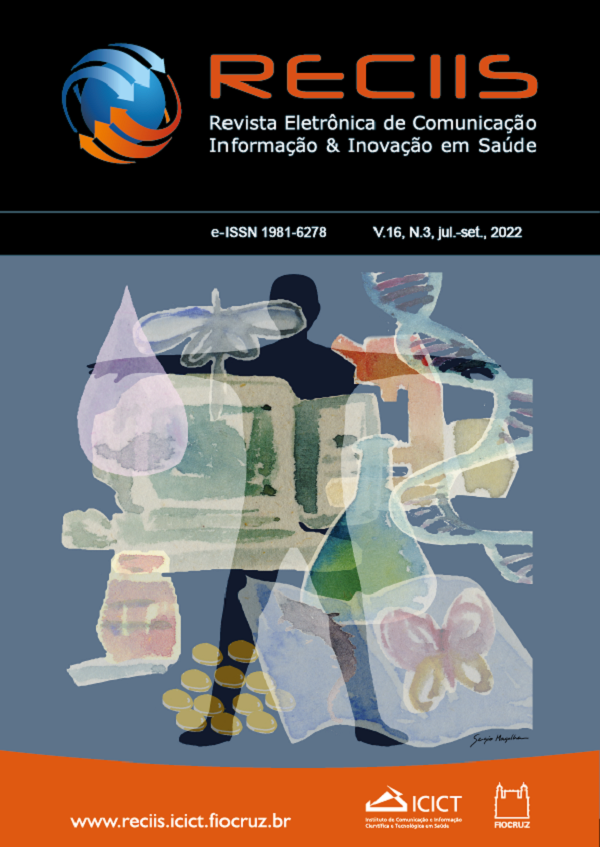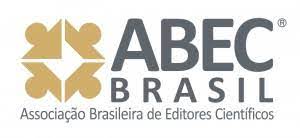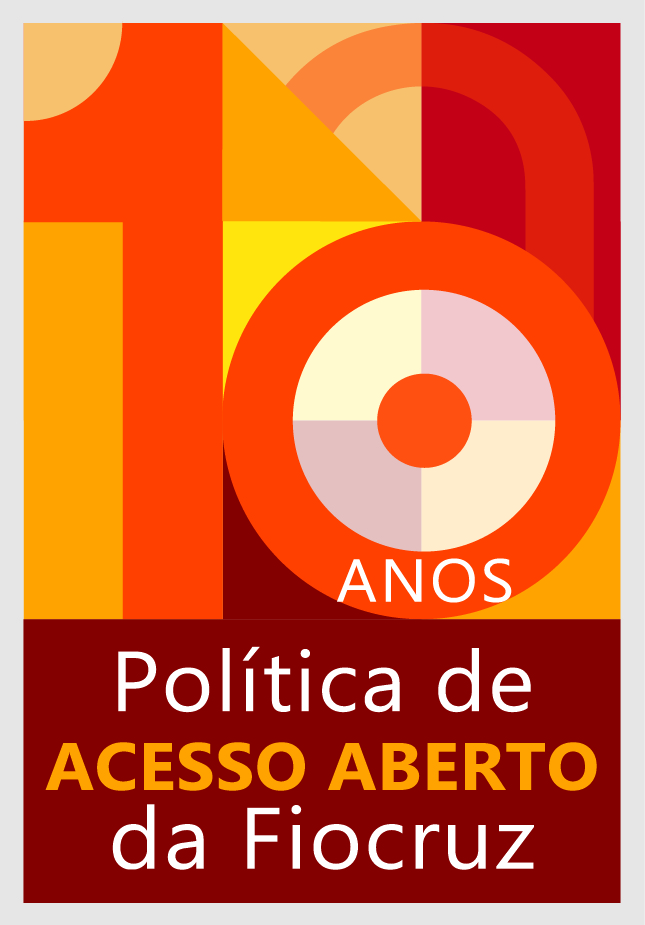Cantinas Survey: proposition and evaluation of an application for the analysis of health risk and of food sold in school canteen
DOI:
https://doi.org/10.29397/reciis.v16i3.2367Keywords:
Mobile applications, Schools, School feeding, Health promotion, Food hygieneAbstract
This article reveals a study presenting the initial version of the technological development and the evaluation of an app for mobile devices that assists in making the data collection, analysis, evaluation and monitoring of healthy school cafeterias. The app was developed in stages, including definition of the research aims, evaluation by specialists, adaptation, practical application in 27 school cafeterias and evaluation of usability, perception and acceptance by users. The app is available for the Android operating system and it is divided into three parts: characterization of the profile of the school cafeteria; health risk consideration; and characteristics of foods offered. The evaluation revealed a satisfactory usability regarding the criteria of effectiveness, efficiency, and user satisfaction. Among the main benefits of using the app, are the greater agility of data collection, processing and analysis, it is easy to use, the standardization of procedures and its economic advantage concerning the environmental sustainability. Future work will involve improving its functionality and making a public version available.
References
AMORIM, Nina Flávia de Almeida et al. Implantação da cantina escolar saudável em escolas do Distrito Federal, Brasil. Revista de Nutrição, Campinas, v. 25, n. 2, p. 203-217, 2012. DOI: https://doi.org/10.1590/S1415-52732012000200003. Disponível em: https://www.scielo.br/j/rn/a/TMH66cTQRLmYnjQZ9nNCVhS/?lang=pt. Acesso em: 2 nov. 2020.
AGÊNCIA NACIONAL DE VIGILÂNCIA SANITÁRIA (Anvisa). Categorização dos serviços de alimentação: elaboração e avalição da lista de avaliação. Brasília, DF: Agência Nacional de Vigilância Sanitária, 2013. E-book. Disponível em: http://www.saude.pi.gov.br/uploads/divisa_document/file/166/Resumo_executivo_final.pdf. Acesso em: 31 mar. 2022.
AGÊNCIA NACIONAL DE VIGILÂNCIA SANITÁRIA (Anvisa). Resolução da Diretoria Colegiada-RDC n. 10, de 11 de março de 2014. Dispõe sobre os critérios para a categorização dos Serviços de alimentação. Diário Oficial da União, Brasília, DF: Agência Nacional de Vigilância Sanitária, 2014. Disponível em: https://bvsms.saude.gov.br/bvs/saudelegis/anvisa/2010/res0010_09_03_2010.html. Acesso em: 31 mar. 2022.
AGÊNCIA NACIONAL DE VIGILÂNCIA SANITÁRIA (Anvisa). Resolução n. 216, de 15 de setembro de 2004. Dispõe sobre Regulamento Técnico de Boas Práticas para Serviços de Alimentação. Diario Oficial da União, Brasília, DF, v. 141, n. 179, p. 25, 16 set. 2004. Seção 1.
BALESTRIN, Mariana et al. Program for healthier school cafeterias in Rio Grande do Sul, Brazil: protocol for a community-based randomized trial. JMIR Research Protocols, Toronto, v. 10, n. 1, p. e22680, 2021. DOI: https://doi.org/10.2196/22680. Disponível em: https://www.researchprotocols.org/2021/1/e22680. Acesso em: 31 mar. 2022.
BELL, A. C.; SWINBURN, B. A. What are the key food groups to target for preventing obesity and improving nutrition in schools? European Journal of Clinical Nutrition, Londres, v. 58, n. 2, p. 258-263, 2004. DOI: https://doi.org/10.1038/sj.ejcn.1601775. Disponível em: https://www.nature.com/articles/1601775. Acesso em: 30 mar. 2022.
BORGES, Camila Aparecida; JAIME, Patricia Constante. Development and evaluation of food environment audit instrument: AUDITNOVA. Revista de Saúde Pública, [s. l.], v. 53, p. 1-19, 2019. DOI: https://doi.org/10.11606/s1518-8787.2019053001316. Disponível em: https://www.revistas.usp.br/rsp/article/view/163290. Acesso em: 5 abr. 2022.
BRASIL. Ministério da Saúde. Manual das cantinas escolares saudáveis: promovendo a alimentação saudável. Brasília, DF: Ministerio da Saúde, 2010.
BRASIL. Ministério da Saúde. Portaria n. 817, de 10 de maio de 2013. Aprova as diretrizes nacionais para a elaboração e execução do projeto-piloto de categorização dos serviços de alimentação para a Copa do Mundo FIFA 2014. Diário Oficial da União, Brasília, DF, v. 150, n. 90, p. 44, 13 maio 2013. Seção 1. Disponível em: http://bvsms.saude.gov.br/bvs/saudelegis/gm/2013/prt0817_10_05_2013.html. Acesso em: 31 mar. 2022.
BRASIL. Ministério da Saúde. Secretaria de Atenção à Saúde. Guia alimentar para a população brasileira. 2. ed. Brasília, DF: Ministério da Saúde, 2014.
BRIAND, Dominique et al. From global action against malaria to local issues: state of the art and perspectives of web platforms dealing with malaria information. Malaria Journal, Londres, v. 17, n. 1, 2018. Artigo 122. DOI: https://doi.org/10.1186/s12936-018-2270-0. Disponível em: https://malariajournal.biomedcentral.com/articles/10.1186/s12936-018-2270-0. Acesso em: 5 abr. 2022.
BROOKE, John. SUS: a quick and dirty usability scale. In: JORDAN, Patrick W. et al. (ed.) Usability evaluation in industry. London: CLC Press, 1996. p. 189-194.
CUNHA, Diogo T. et al. Inspection score and grading system for food services in Brazil: the results of a food safety strategy to reduce the risk of foodborne diseases during the 2014 FIFA World Cup. Frontiers in Microbiology, Lausanne, v. 7, 2016. Artigo 614. DOI: https://doi.org/10.3389/fmicb.2016.00614. Disponível em: https://www.frontiersin.org/article/10.3389/fmicb.2016.00614. Acesso em: 31 mar. 2022.
CUNHA, Diogo T. et al. Food safety of food services within the destinations of the 2014 FIFA World Cup in Brazil: Development and reliability assessment of the official evaluation instrument. Food Research International, [s. l.], v. 57, p. 95-103, 2014. DOI: https://doi.org/10.1016/j.foodres.2014.01.021. Disponível em: https://www.sciencedirect.com/science/article/pii/S0963996914000271?via%3Dihub. Acesso em: 31 mar. 2022.
DÍEZ, Julia et al. Socioeconomic inequalities in the retail food environment around schools in a Southern European context. Nutrients, Basel, v. 11, n. 7, 2019. Artigo 1511. DOI: https://doi.org/10.3390/nu11071511.Disponível em: https://www.mdpi.com/2072-6643/11/7/1511. Acesso em: 6 ago. 2020.
EVENHUIS, I. J. et al. Development of the “Canteen Scan”: an online tool to monitor implementation of healthy canteen guidelines. BMC Public Health, Londres, v. 18, 2018. Artigo 1109. DOI: https://doi.org/10.1186/s12889-018-5974-8. Disponível em: https://bmcpublichealth.biomedcentral.com/articles/10.1186/s12889-018-5974-8. Acesso em: 31 mar. 2022.
FERRO, Élen Lúcia Bagatini Saud et al. Cantina escolar e sua influência no estado nutricional. Brazilian Journal of Development, Curitiba, v. 5, n. 10, p. 19723-19738, 2019. DOI: https://doi.org/10.34117/bjdv5n10-187. Disponível em: https://brazilianjournals.com/index.php/BRJD/article/view/3841. Acesso em: 31 mar. 2022.
GABRIEL, Cristine Garcia et al. First Law regulating school canteens in Brazil: Evaluation after seven years of implementation. Archivos Latinoamericanos de Nutricion, Caracas, v. 59, n. 2, p. 128-138, 2009. Disponível em: http://ve.scielo.org/scielo.php?pid=S0004-06222009000200003&script=sci_abstract&tlng=en. Acesso em: 8 maio 2020.
GABRIEL, Cristine Garcia; SANTOS, Melina Valério dos; VASCONCELOS, Francisco de Assis Guedes de. Avaliação de um programa para promoção de hábitos alimentares saudáveis em escolares de Florianópolis, Santa Catarina, Brasil. Revista Brasileira de Saúde Materno Infantil, Recife, v. 8, n. 3, p. 299-308, 2008. DOI: https://doi.org/10.1590/S1519-38292008000300009. Disponível em: https://www.scielo.br/j/rbsmi/a/Hxfrn6DCzpwLjr8xz3CVVWm/?lang=pt. Acesso em: 8 jul. 2020.
GAETANI, Raquel dos Santos; RIBEIRO, Luciana Cisoto. Products sold in school canteens of the municipality of Ribeirão. Revista Brasileira em Promoção da Saúde, Fortaleza, v. 28, n. 4, p. 587-595, 2015. DOI: https://doi.org/10.5020/18061230.2015.p587. Disponível em: https://periodicos.unifor.br/RBPS/article/view/4005. Acesso em: 5 abr. 2022.
GEBREMARIAM, Mekdes K. et al. Measurement of availability and accessibility of food among youth: a systematic review of methodological studies. The International Journal of Behavioral Nutrition and Physical Activity, Londres, v. 14, n. 1, p. 22, 2017. DOI: https://doi.org/10.1186/s12966-017-0477-z. Disponível em: https://ijbnpa.biomedcentral.com/articles/10.1186/s12966-017-0477-z. Acesso em: 6 jul. 2020.
GIACOMELLI, Simone de Castro. Avaliação e promoção das boas práticas em cantinas escolares. 2014. 212 f. Dissertação (Mestrado em Ciência e Tecnologia de Alimentos) – Universidade Federal de Santa Maria, 2014. Disponível em: https://repositorio.ufsm.br/handle/1/5763. Acesso em: 4 jul. 2020.
GIACOMELLI, Simone de Castro et al. Comércio informal e formal de alimentos no âmbito escolar de um município da região central do Rio Grande do Sul. Brazilian Journal of Food Technology, Campinas, v. 20, p. e2016136, 2017. DOI: https://doi.org/10.1590/1981-6723.13616. Disponível em: https://www.scielo.br/j/bjft/a/7cHqnGjbn6GpwkMBQwHmQwn/?lang=pt. Acesso em: 9 ago. 2020.
GLANZ, Karen et al. Healthy nutrition environments: concepts and measures. American Journal of Health Promotion, Royal Oak, v. 19, n. 5, p. 330-333, 2005. DOI: https://doi.org/10.4278/0890-1171-19.5.330. Disponível em: https://journals.sagepub.com/doi/10.4278/0890-1171-19.5.330. Acesso em: 5 nov. 2020.
GLANZ, Karen et al. Measures of retail food store environments and sales: review and implications for healthy eating initiatives. Journal of Nutrition Education and Behavior, Hamilton, v. 48, n. 4, p. 280-288.e1, 2016. DOI: https://doi.org/10.1016/j.jneb.2016.02.003. Disponível em: https://www.sciencedirect.com/science/article/pii/S1499404616000543?via%3Dihub. Acesso em: 5 abr. 2022.
LASSEN, Anne D. et al. The nutritional quality of lunch meals eaten at Danish worksites. Nutrients, Bagel, v. 10, n. 10, p. 1-11, 2018. Artigo 1518. DOI: https://doi.org/10.3390/nu10101518. Disponível em: https://www.mdpi.com/2072-6643/10/10/1518. Acesso em: 5 abr. 2022.
LOPES FILHO, José Divino; MENDES, Larissa Loures. Comercialização de lanches e bebidas em escolas públicas: análise de uma regulamentação estadual. Demetra: alimentação, nutrição & saúde, Rio de Janeiro, v. 11, n. 4, p. 991-1000, 2016. DOI: https://doi.org/10.12957/demetra.2016.19641. Disponível em: https://www.e-publicacoes.uerj.br/index.php/demetra/article/view/19641. Acesso em: 8 maio 2020.
LYTLE, Leslie A; SOKOL, Rebeccah L. Measures of the food environment: a systematic review of the field, 2007–2015. Health & Place, Exford, v. 44, p. 18-34, 2017. Disponível em: https://doi.org/https://doi.org/10.1016/j.healthplace.2016.12.007. Acesso em: 8 jul. 2020.
MACHADO, Christiane Opuszka; HÖFELMANN, Doroteia Aparecida. Cantinas de escolas estaduais de Curitiba/PR, Brasil: adequação à lei de regulamentação de oferta de alimentos. Ciência & Saúde Coletiva, Rio de Janeiro, v. 24, n. 10, p. 3805-3814, 2019. DOI: https://doi.org/10.1590/1413-812320182410.00272018. Disponível em: https://www.scielo.br/j/csc/a/mmr4Pxnmp3VtChjpNLNYssy/?lang=pt. Acesso em: 31 mar. 2022.
MCMAHON, Emma Joy; JAENKE, Rachael; BRIMBLECOMBE, Julie. A mobile app to rapidly appraise the instore food environment: reliability, utility, and construct validity study. JMIR mHealth and uHealth, Toronto, v. 8, n. 7, p. e16971, 2020. DOI: https://doi.org/10.2196/16971. Disponível em: https://mhealth.jmir.org/2020/7/e16971. Acesso em: 30 mar. 2022.
NATHAN, Nicole et al. Barriers and facilitators to the implementation of physical activity policies in schools: a systematic review. Preventive Medicine, Nova York, v. 107, p. 45-53, 2018. DOI: https://doi.org/10.1016/J.YPMED.2017.11.012. Disponível em: https://www.sciencedirect.com/science/article/pii/S0091743517304516?via%3Dihub. Acesso em: 29 maio 2018.
NIELSEN, Jakub. How many test users in a usability study?. Nielsen Normal Group, [s. l.], 3 jun. 2012. User Testing. Disponível em: https://www.nngroup.com/articles/how-many-test-users/. Acesso em: 21 set. 2021.
PENNEY, Tarra L et al. Modifying the food environment for childhood obesity prevention: challenges and opportunities. Proceedings of the Nutrition Society, [s. l.], v. 73, n. 2, p. 226-236, 2014. DOI: https://doi.org/10.1017/S0029665113003819. Disponível em: https://www.cambridge.org/core/journals/proceedings-ofthe-nutrition-society/article/modifying-the-food-environment-for-childhood-obesity-prevention-challenges-andopportunities/D52BD4F8FD00D0A9A172B97546757F03. Acesso em: 5 abr. 2022.
PEREIRA, Irene Mari et al. Tecnologia móvel para coleta de dados de pesquisas em saúde. Acta Paulista de Enfermagem, São Paulo, v. 30, n. 5, p. 479-488, 2017. DOI: https://doi.org/10.1590/1982-0194201700069. Disponível em: https://www.scielo.br/j/ape/a/Qxfrqv8yW3LSZBGH9SWpXbv/abstract/?lang=pt. Acesso em: 5 abr. 2022.
PORTO, Erika Blamires et al. Condições higiênico-sanitárias das cantinas de escolas públicas e privadas do Distrito Federal: Brasil e seus fatores associados. Visa em Debate, Rio de Janeiro, v. 3, n. 4, p. 128-135, 2015. DOI: https://doi.org/10.3395/2317-269x.00317. Disponível em: https://visaemdebate.incqs.fiocruz.br/index.php/visaemdebate/article/view/317. Acesso em: 5 abr. 2022.
REILLY, Kathryn et al. Assessing the potential impact of a front-of-pack nutritional rating system on food availability in school canteens: a randomised controlled trial. Appetite, Londres, v. 121, p. 309-315, 2018. DOI: https://doi.org/10.1016/j.appet.2017.11.103. Disponível em: https://www.sciencedirect.com/science/article/pii/S019566631730288X?via%3Dihub. Acesso em: 17 jul. 2018.
ROSE, Donald et al. Neighborhood food environments and body mass index: the importance of in-store contents. American Journal of Preventive Medicine, Nova York, v. 37, n. 3, p. 214-219, 2009. DOI: https://doi.org/10.1016/j.amepre.2009.04.024. Disponível em: https://www.sciencedirect.com/science/article/pii/S0749379709003821?via%3Dihub. Acesso em: 5 abr. 2022.
SÃO PAULO (Estado). Portaria Conjunta COGSP/CEI/DSE, de 23 de março de 2005. Normas para funcionamento de cantinas escolares. Diário Oficial, São Paulo, a. 131, n. 147, p. 149, 2005. Seção I. Disponível em: http://siau.edunet.sp.gov.br/ItemLise/arquivos/notas/portconj_cogsp_cei_dse(doe230305).htm. Acesso em: 23 maio 2020.
SILVA-SANIGORSKI, Andrea et al. Government food service policies and guidelines do not create healthy school canteens. Australian and New Zealand Journal of Public Health, Canberra, v. 35, n. 2, p. 117-121, 2011. DOI: https://doi.org/10.1111/j.1753-6405.2010.00694.x. Disponível em: https://onlinelibrary.wiley.com/doi/10.1111/j.1753-6405.2010.00694.x. Acesso em: 5 abr. 2022.
VENKATESH, Viswanath; BALA, Hillol. Technology acceptance model 3 and a research agenda on interventions. Decision Sciences, [s. l.], v. 39, n. 2, p. 273-315, 2008. DOI: https://doi.org/10.1111/j.1540-5915.2008.00192.x. Disponível em: https://onlinelibrary.wiley.com/doi/10.1111/j.1540-5915.2008.00192.x. Acesso em: 31 mar. 2022.
VERDUM, Daiane Piovesan et al. Condições higiênico-sanitárias das cantinas escolares da rede estadual de ensino no município de Palmeira das Missões, Rio Grande do Sul. Vigilância Sanitária em Debate, Rio de Janeiro, v. 5, n. 4, p. 17-23, 2017. DOI: https://doi.org/10.22239/2317-269x.00960. Disponível em: https://visaemdebate.incqs.fiocruz.br/index.php/visaemdebate/article/view/960. Acesso em: 1 dez. 2020.
WOGNSKI, Ana Claudia Pereira et al. Comercialização de alimentos em cantinas no âmbito escolar. Brazilian Journal of Food Technology, Campinas, v. 22, p. e2018198, 2019. DOI: https://doi.org/10.1590/1981-6723.19818. Disponível em: https://www.scielo.br/j/bjft/a/MwKD78LFrmQDq9HWj5vgQ3w/?lang=pt. Acesso em: 8 ago. 2020.
WORLD HEALTH ORGANIZATION (WHO). Classification of digital health interventions v1.0: a shared language to describe the uses of digital technology for health. Genebra: WHO, 2018. Disponível em: https://www.who.int/reproductivehealth/publications/mhealth/classification-digital-health-interventions/en/. Acesso em: 19 maio 2020.
Downloads
Published
How to Cite
Issue
Section
License
Copyright (c) 2022 Mariana Balestrin, Carla Cristina Bauermann Brasil, Ericles Andrei Bellei, Ana Carolina Bertoletti De Marchi, Vanessa Ramos Kirsten, Mario Bernardes Wagner

This work is licensed under a Creative Commons Attribution-NonCommercial 4.0 International License.
Author’s rights: The author retains unrestricted rights over his work.
Rights to reuse: Reciis adopts the Creative Commons License, CC BY-NC non-commercial attribution according to the Policy on Open Access to Knowledge by Oswaldo Cruz Foundation. With this license, access, download, copy, print, share, reuse, and distribution of articles is allowed, provided that it is for non-commercial use and with source citation, granting proper authorship credits and reference to Reciis. In such cases, no permission is required from the authors or editors.
Rights of authors’s deposit / self-archiving: The authors are encouraged to deposit the published version, along with the link of their article in Reciis, in institutional repositories.












